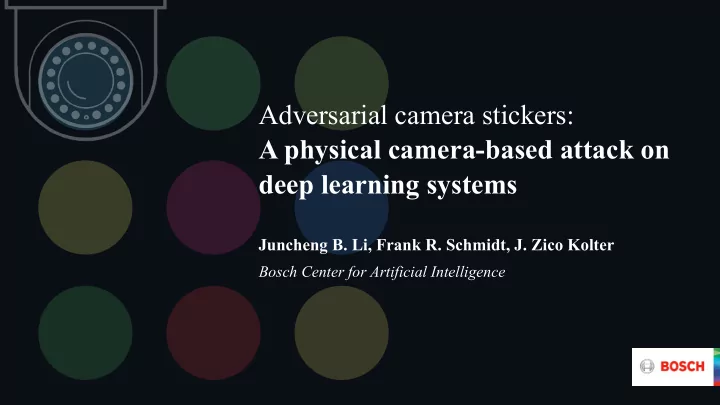

Adversarial camera stickers: A physical camera-based attack on deep learning systems Adversarial camera stickers: A physical camera-based attack on deep learning systems Juncheng B. Li, Frank R. Schmidt, J. Zico Kolter Bosch Center for Artificial Intelligence 1 Juncheng B. Li, Frank R. Schmidt, J. Zico Kolter | Bosch Center for Artificial Intelligence
Adversarial attacks: not just a digital problem All existing physical attacks modify the object . Sharif et al., 2016 Etimov et al., 2017 Athalye et al., 2017 2 Juncheng B. Li, Frank R. Schmidt, J. Zico Kolter | Bosch Center for Artificial Intelligence
QUESTION All existing physical attacks modify the object , but is it possible instead to fool deep classifiers by modifying the camera ? 3 Juncheng B. Li, Frank R. Schmidt, J. Zico Kolter | Bosch Center for Artificial Intelligence
This paper: A physical adversarial camera attack • We show it is indeed possible to create visually inconspicuous modifications to a camera that fool deep classifiers • Uses a small specially-crafted translucent sticker, placed upon camera lens • The adversarial attack is universal , meaning that a single perturbation can fool the classifier for a given object class over multiple viewpoints and scales 4 Juncheng B. Li, Frank R. Schmidt, J. Zico Kolter | Bosch Center for Artificial Intelligence
The challenge of physical sticker attacks The challenge Our solution • (Inconspicuous) physical stickers • A differentiable model of sticker are extremely limited in their perturbations, based upon alpha resolution (can only create blurry blending of blurred image overlays dots over images) • Use gradient descent to both fit the • Need to both learn a model of perturbation model to observed data, allowable perturbations and create and construct an adversarial attack the adversarial image 5 Juncheng B. Li, Frank R. Schmidt, J. Zico Kolter | Bosch Center for Artificial Intelligence
Methodology • Attack model consists of smoothed alpha blend between observed image and some fixed color (iterated to produce multiple dots) The Transparent Sticker • Parameters of attack include color c , dot position ( x c , y c ) and bandwidth σ • Key idea: use gradient descent over some parameters (e.g., color, bandwidth) to fit model to observed physical images, over other parameters (e.g. location) to maximize loss • 6 Juncheng B. Li, Frank R. Schmidt, J. Zico Kolter | Bosch Center for Artificial Intelligence
How does a dot look like through camera lense? Clean Camera View Red Dot Resulting Blur Simulated Blur 8 7 Juncheng B. Li, Frank R. Schmidt, J. Zico Kolter | Bosch Center for Artificial Intelligence Juncheng B. Li, Frank R. Schmidt, J. Zico Kolter | Bosch Center for Artificial Intelligence
Results: Virtual Evaluation Table 1. Performance of our 6-dot attacks on ImageNet test set Class Attack Prediction Correct Target Other Keyboard No 85% 15% Mouse Yes 48% 16% 36% Street sign No 64% 36% Guitar Pick Yes 32% 34% 34% Street sign No 64% 36% Yes 50 random classes 18% 49% 33% 50 random classes No 74% 26% Yes 50 random classes 42% 27% 31% 8 Juncheng B. Li, Frank R. Schmidt, J. Zico Kolter | Bosch Center for Artificial Intelligence
9 Juncheng B. Li, Frank R. Schmidt, J. Zico Kolter | Bosch Center for Artificial Intelligence
10 Juncheng B. Li, Frank R. Schmidt, J. Zico Kolter | Bosch Center for Artificial Intelligence
This is a ResNet-50 model implemented with PyTorch deployed on a Logitech C920 WebCam with clear lense. It can recognize street sign at different angles with only minor errors. 11 Juncheng B. Li, Frank R. Schmidt, J. Zico Kolter | Bosch Center for Artificial Intelligence
Now we cover the camera with our adversarial sticker made by our proposed method to achieve the targeted attack. This should make a “street sign” misclassified as a “guitar pick”. 12 Juncheng B. Li, Frank R. Schmidt, J. Zico Kolter | Bosch Center for Artificial Intelligence
The Sticker results in very inconspicuous blurs in the view. We can achieve targeted attack most of the time at different angles and with different distances. 13 Juncheng B. Li, Frank R. Schmidt, J. Zico Kolter | Bosch Center for Artificial Intelligence
Results: Real World Evaluation Prediction Original Target Class class Correct Target Other Mouse 271 548 181 Keyboard Space bar 320 522 158 Guitar Pick 194 605 201 Street sign Envelope 222 525 253 Coffee Candle 330 427 243 mug Table 2. Fooling performance of the our method on two 1000 frame videos of a computer keyboard and a stop sign, viewed through a camera with an adversarial sticker placed on it targeted for these attacks. 14 Juncheng B. Li, Frank R. Schmidt, J. Zico Kolter | Bosch Center for Artificial Intelligence
ICML 2019, Long Beach California, 6/11/2019 Summary • Adversarial attacks don’t need to modify every object in the world to fool a deployed deep classifier, they just need to modify the camera • Implications in self-driving cars, security systems, many other domains To find out more, come see our poster Pacific Ballroom #65 at on Tuesday, Jun 11th 06:30-09:00 15 Juncheng B. Li, Frank R. Schmidt, J. Zico Kolter | Bosch Center for Artificial Intelligence
Recommend
More recommend